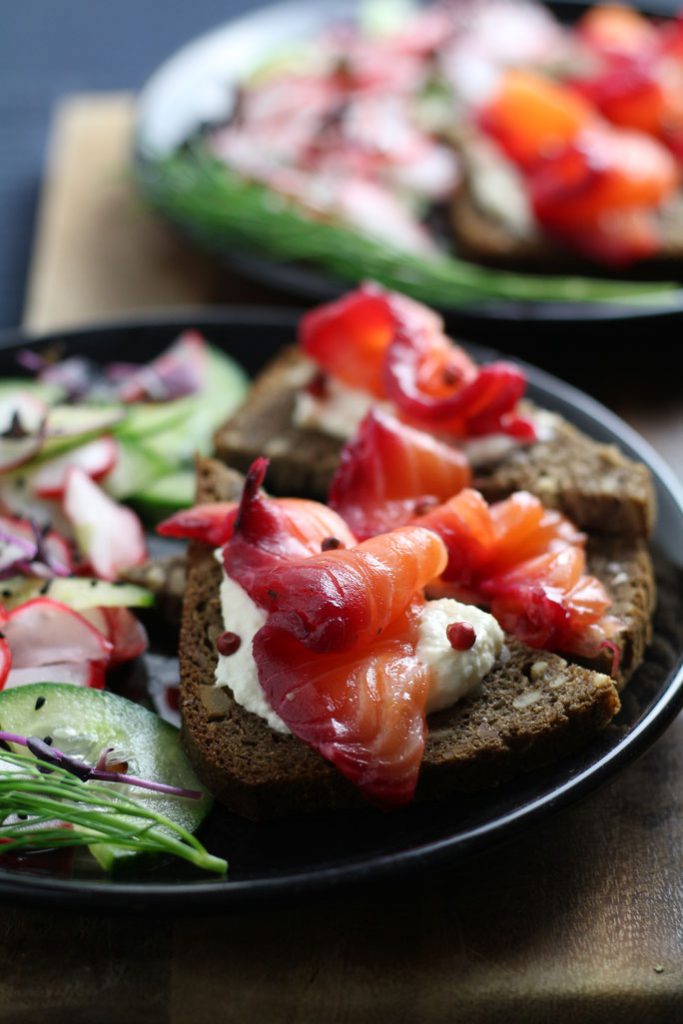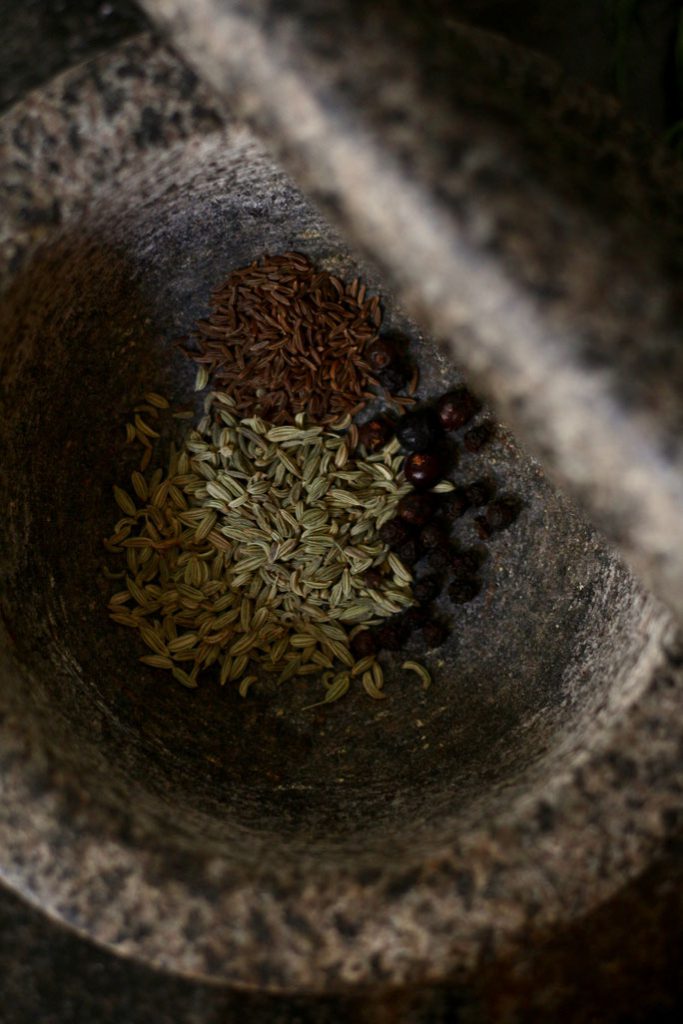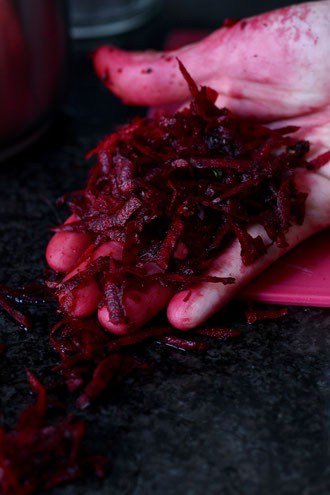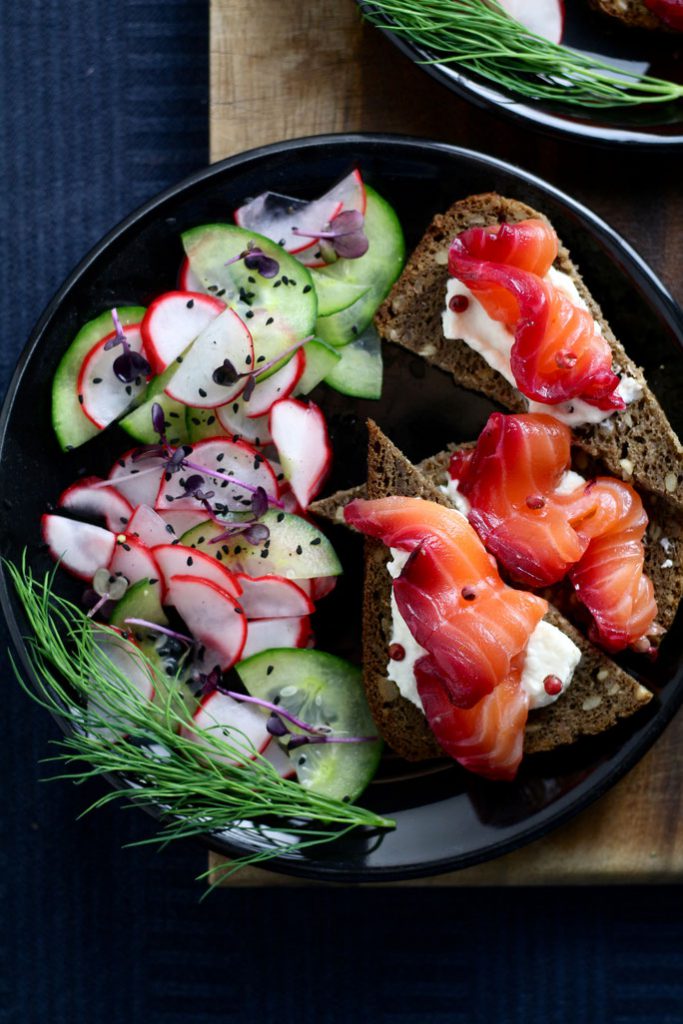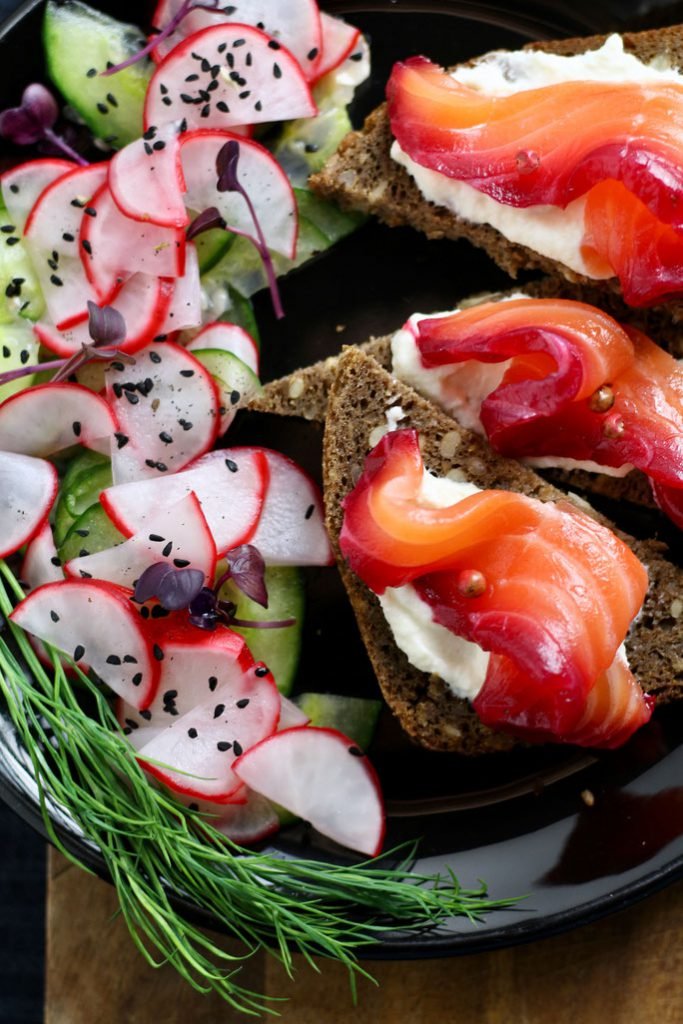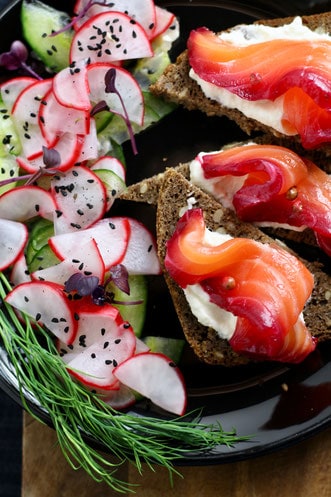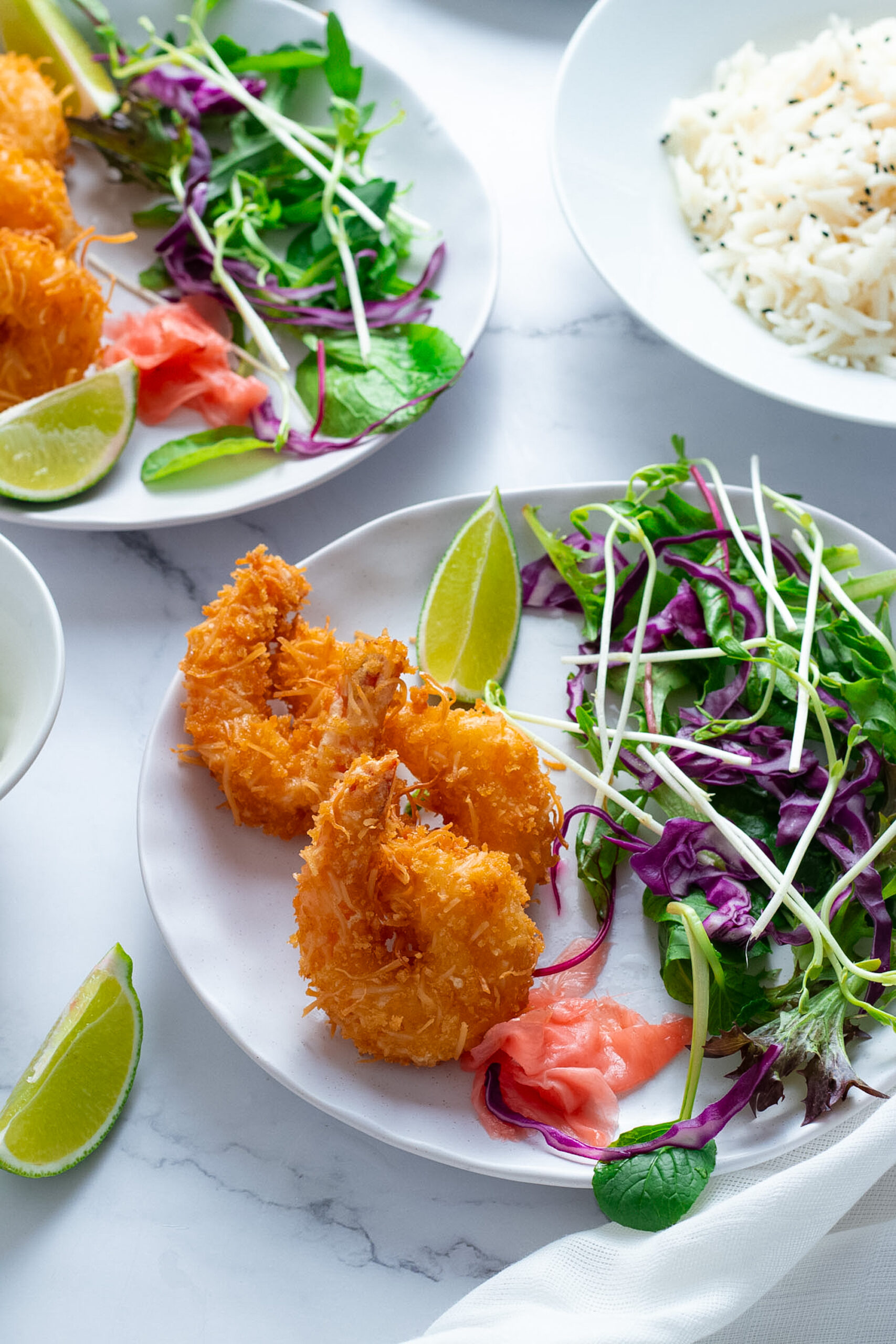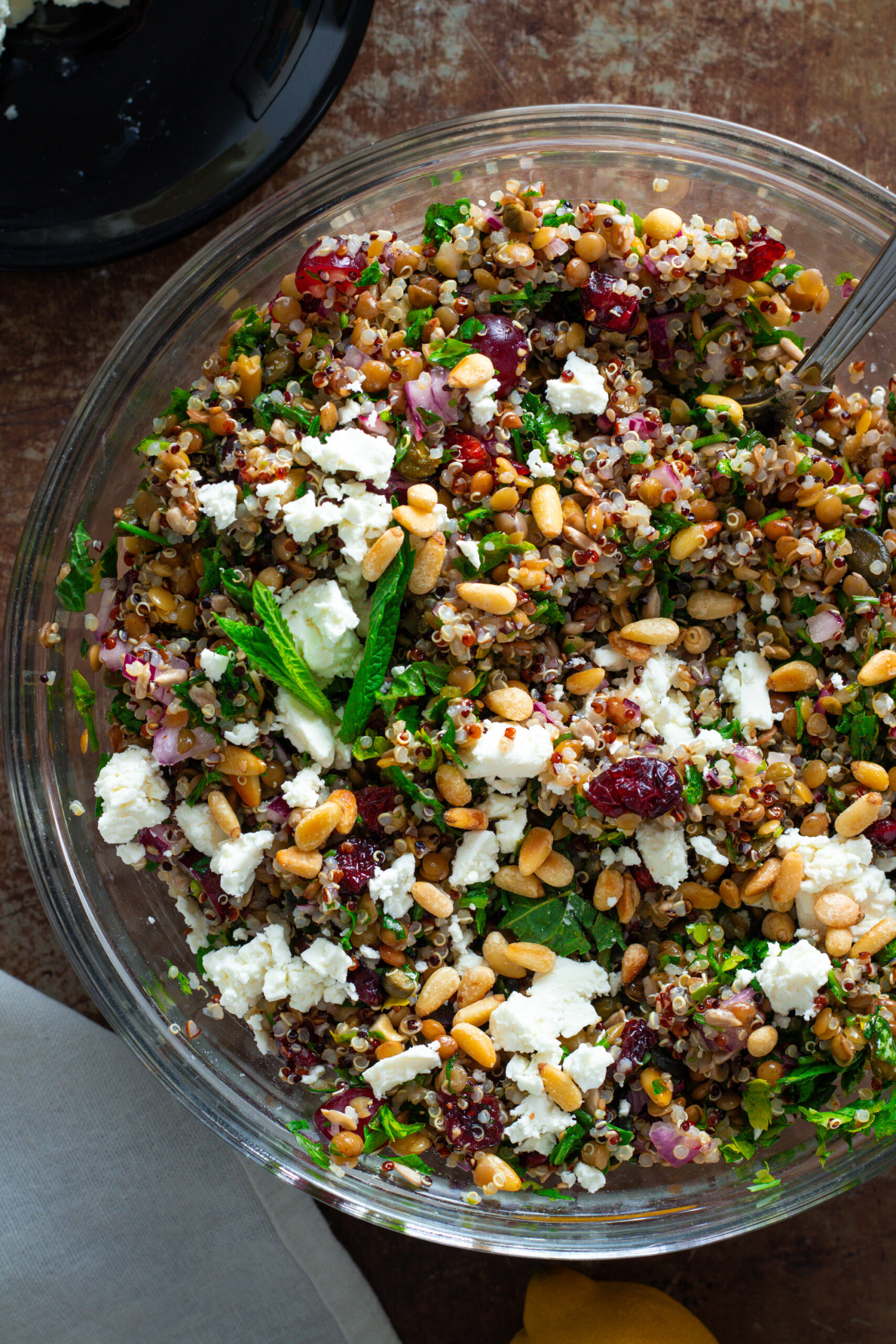
Beetroot Cured Salmon Gravadlax

We’ve landed back in beautiful Munich to the clear and crisp skies and very chilly nights of late winter. It’s not quite spring yet, but the promise of it hangs in the air, brightening the mood and sending the locals outside to soak up every last bit of available sun.
I’m rather enjoying the opportunity to rattle around in my kitchen, baking, making stews and pastries and all those other things that are so much more appealing when the kitchen is cool.
TABLE OF CONTENTS
▼
If someone had told me as a child that the day would come when I would look forward to pickled or cured fish as a special treat, I would have entertained serious doubts about their sanity. However, tastes change, and sure enough, I’ve been stocking up on pickled herring (so good! It’s amazing for hangovers!) and curing a lovely piece of salmon with bright and earthy beetroot.
This dish is stunning and always elicits oohs and aahs. The deep coral of the salmon contrasts with the shocking purple of the beetroot. Home-curing fish may seem mysterious, but it’s actually simple. Just combine salt, sugar, and spices, and let time and the refrigerator work their magic.
The herbs and spices I have used here are fairly traditional but not binding – you can mix them up to suit your tastes. Do use strong, pungently flavoured spices for maximum flavour.
For example, ginger and wasabi make excellent flavour bases for Japanese-influenced dishes. Keep the ratio of salt to sugar (50/50 works well, too, but I prefer mine a little sweeter) and scale up as necessary for a larger piece of fish.
FREQUENTLY ASKED QUESTIONS
Can I use frozen salmon to make Beetroot Cured Salmon Gravadlax?
This recipe works beautifully with frozen salmon and is an excellent way of making a really luxurious dish on a budget. However, make sure that the salmon has the skin still on, or it will be a pain to slice.
Is it safe to eat the cured salmon?
It is! If you are at all unsure of the provenance of your fish or are extra cautious, freezing the fish for at least 72 hours before curing will ensure that there are no parasites in the fish. Much of the fish that we can buy in the shops has already been frozen for transport and carefully checked for quality, before being defrosted for sale in the shops, but it is worth knowing. There’s plenty of information about this online
How long will the salmon keep once it is cured?
At least 4-5 days in the fridge.
BEET CURED SALMON GRAVADLAX Recipe
Beetroot Cured Salmon Gravadlax
This is a stunner of a dish and always elicits oohs and aahs, not only because it is truly beautiful with the deep coral of the salmon contrasting with the shocking purple of the beetroot, but delicious as well.
Ingredients
- 500 g salmon, skin on
- 1 large beetroot, peeled
- 25 g bunch of dill
- 2.5 Tbsp sugar
- 2 Tbsp rock salt
- 1 tsp fennel seeds
- 1 tsp caraway seeds
- 1 tsp whole black peppercorns
- ½ tsp juniper berries
- zest of 1 unwaxed orange
for the pickled vegetables:
- 4-6 radishes
- 1/2 of a small cucumber
- 1 tsp salt
- 3 Tbsp vinegar
- 2 tsp sugar
- freshly ground black pepper
for the creamy horseradish:
- 100 g cream cheese
- 2 Tbsp horseradish, from the jar
to serve:
- dark rye bread
- fresh dill
Instructions
- Line a deep-sided dish with a double layer of cling film, leaving plenty overhanging the sides, and place the salmon on top. Check the salmon for any bones and remove them with tweezers if necessary.
- Coarsely grate the beetroot into a large bowl, chop the dill finely and stir through the beetroot, along with the sugar and salt.
- Using a mortar and pestle, spice grinder or a large knife, roughly crush the fennel, caraway, peppercorns and juniper berries, then add to the beetroot mixture with the orange zest. By this stage, your kitchen will be full of the most incredibly fragrant aroma and you’ll be feeling positively Scandinavian.
- Spread the mixture evenly over the salmon, tucking some underneath so that it is fully covered. Wrap firmly with the overhanging cling film, place a plate or small chopping board (preferably something that won’t stain if in contact with beetroot juice) on top of the parcel, then weigh it down with something heavy. People often recommend a couple of tins, but I prefer not to have tins in the refrigerator so I use a couple of jars of olives or similar.
- Place the salmon in the refrigerator, and allow to cure for 24-36 hours, turning every 12 hours. For me, the salmon is perfect after 36 hours, but if you are using a very thin piece or prefer a lighter cure then 24 hours will be fine.
- When the fish has cured, remove from the refrigerator, scrape off the cure and discard it. Unfortunately, it is too salty to be put to any further use. The salmon will now be a vibrant purple and can be stored in an airtight container in the refrigerator for 3-4 days until you are ready to serve.
- Before serving, I like to put the salmon in the freezer for 30 minutes as this makes the flesh really easy to slice finely.
- While the fish is in the freezer, make the pickled vegetables by slicing the radishes and cucumber finely. Place in a colander or a sieve and sprinkle over the salt. Allow to drain for 5-10 minutes, then gently squeeze out any excess moisture. Place the vegetables into a shallow dish.
- Whisk together the vinegar, sugar, and pepper and pour over the vegetables. Toss to combine, then set aside until you are ready to serve.
- Just before serving, pile the pickled vegetables onto plates, then use your sharpest knife to cut thin slices of the salmon. If you angle the knife slightly while cutting you can get wider pieces of fish. Stir together the cream cheese and horseradish, spread a little over a few slices of rye bread and top with the salmon. Serve with fresh dill and plenty of cracked pepper.
As an Amazon Associate and member of other affiliate programs, I earn from qualifying purchases.
Nutrition
Serving: 1portion | Calories: 346kcal | Carbohydrates: 20g | Protein: 28g | Fat: 17g | Saturated Fat: 6g | Polyunsaturated Fat: 4g | Monounsaturated Fat: 5g | Cholesterol: 94mg | Sodium: 4349mg | Potassium: 926mg | Fiber: 3g | Sugar: 16g | Vitamin A: 417IU | Vitamin C: 6mg | Calcium: 73mg | Iron: 2mg
Tried this recipe?I’d love to hear how it went! Please leave a review or a star rating and let me know how it was! Use the hashtag #daysofjay on Instagram so I can see your delicious creations.

About the Author
Jay Wadams is a cookbook author, food photographer, and graduate of Le Cordon Bleu in Gastronomy and Nutrition.
Based in Italy 🇮🇹 Germany 🇩🇪 and Australia 🇦🇺.


